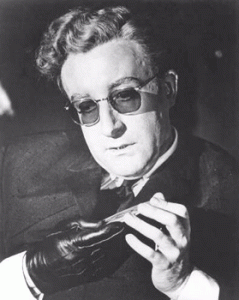
A slight moment of lamentation must precede my review of Dr. Strangelove, for each time I revisit it, even in my memory, I am reminded of how far we have fallen since this film was released. Stanley Kubrick, just entering his second phase (which would last until his final masterpiece), has given the world a film so full of life, so audacious in its premise and execution, that just about any film is bound to suffer in comparison. First, it features a brilliant cast: Peter Sellers (in three wonderful roles, he was surely robbed of an Oscar), George C. Scott (proving that he had a natural gift for comedy), Slim Pickens (providing one of the most justifiably famous scenes in cinema history), Sterling Hayden, and Keenan Wynn.
The story (for all those unfamiliar — shame on you), involves a paranoid Air Force Commander (Hayden as “Jack D. Ripper”) and his mad plot to hit the Soviet Union with a nuclear strike before they, in his words, “sap and impurify our precious bodily fluids.” Pickens (as “Major Kong”) is the pilot of a B-52 bomber sent to deliver the fatal strike and Sellers (this time as “Captain Mandrake”) is a suspicious British officer trying to discover the secret code that will allow the plane to be recalled. In the midst of all this madness, Sellers (as “President Muffley”) argues with the jingoistic, Curtis LeMay-like1 Scott (playing “General Buck Turgidson”) while trying to convince the drunken Soviet premier that the threat is in fact real.
Still, a mere plot summary does little justice to the overall impact of this film. Due to the masterful hand of Kubrick, the film is perfectly staged; not a moment is wasted and every scene contains wonderful dialogue and black humor. While the film is not as deliberately paced as subsequent Kubrick films (this was his last non-epic in a sense), it uses that frantic pace to explore Kubrick’s recurrent themes: the perversion of language (using euphemism and deception to retreat from reality), ritual in human behavior (and how such a reliance leads to powerlessness), the linking of sex and death, and the self-righteous paranoia of Americanism. Despite those heavy themes (it wouldn’t be Kubrick without them), the film remains hilarious from start to finish.
Most of all, the film is one of the most courageous ever made because it remains true to its logic2. Without succumbing to easy answers or forced conclusions (no last-minute heroics here), “Dr. Strangelove,” like a good Ambrose Bierce short story or H.L. Mencken essay, takes pleasure in its cynicism and would prefer to sit back, toast the insanity, and laugh as the world burns.
Ruthless Ratings
- Overall: 10
- Direction: 10
- Acting: 10
- Story: 10
- DVD Extras: 10 (It’s just the movie)
- Re-watchability: 10+
Ruthless Notes
- 1 General Curtis LeMay was responsible for putting together SAC, or Strategic Air Command, which gave our country “nation killing” capabilities as well wrestling control for “the button” away from the President. LeMay is probably not only the inspiration for General Buck Turgidson in Dr. Strangelove, but Base Commander Jack D. Ripper as well. One of the most Ruthless motherfuckers in history, LeMay oversaw the fire-bombing of Tokyo where more than 300,000 people died. To give you a sense of scale, about 200,000 people died in Hiroshima and Nagasaki combined. LeMay of course, was also involved with dropping both of the big bombs. Basically, LeMay was personally responsible for the Cold War. And, of course, John Milius’s lifelong dream is to write and direct a fair and balanced portrayal of LeMay
- 2 The movie is so effective, that all incoming Air Force recruits are required to watch Dr. Strangelove.